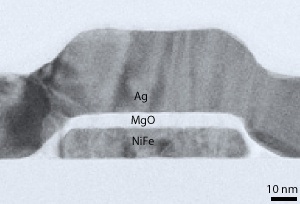| Sep 12, 2011 |
Spintronics: Lateral voltage boost
|
|
(Nanowerk News) The use of an electron's spin polarization in addition to its charge to realize ultrafast, low-power electronics-like functionality is fast becoming a reality. One of the major obstacles that remains to be addressed effectively, however, is the generation of the high-purity 'spin current' needed for reliable 'spintronics' devices. Spin valves, a type of multilayer magnetic system, have already been applied in devices such as magnetic memory, but their strict spin-based regulation of the flow of mobile electrons also makes them promising for the generation of pure spin currents.
|
|
Yasuhiro Fukuma and colleagues from the RIKEN Advanced Science Institute and other institutions in Japan have now tailored the interface properties in a lateral spin valve in a way that significantly improves the efficiency of spin injection and the spin valve voltage ("Giant enhancement of spin accumulation and long-distance spin precession in metallic lateral spin valves").
|
 |
| A cross-sectional transmission electron microscopy image of the NiFe/MgO/Ag junction. (© 2011 Nature Publishing Grouyp)
|
|
Spin valves typically consist of two ferromagnetic electrodes separated by an insulating tunnel barrier. They regulate the flow of mobile electrons based on the electrons' spin — a magnetism-related quantum property that can be oriented either 'up' or 'down' — in relation to the direction of the magnetization in the magnetic layers. Lateral spin valves, in which the spin transport occurs parallel to the layers, are particularly attractive because they enable the generation of pure spin currents. "A pure spin current is actually a flow of spin angular momentum with no accompanying charge current," explains Fukuma.
|
|
The researchers used MgO tunnel junctions of different thicknesses, sandwiched between ferromagnetic electrodes of NiFe and silver (see image). These NiFe/MgO/Ag junctions were then annealed in nitrogen and hydrogen. "The annealing not only improves the spin injection efficiency of the junction, but also reduces the junction resistance, leading to a giant enhancement of the spin accumulation in lateral spin valves," says Fukuma.
|
|
The efficient injection of polarized spin from the NiFe source into the silver wire across the MgO tunnel junction results in the generation of a spin voltage that is orders of magnitude larger than previously obtained in lateral spin valves. "The high spin valve voltage will accelerate the development of active spintronic elements such as spin transistors and spin logic devices," says Fukuma.
|

